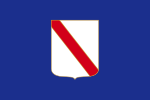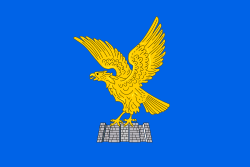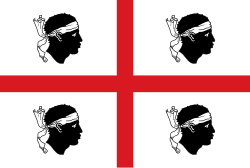Flags of regions of Italy
Appearance
The twenty
gonfalone; more recently they have taken into use normal flags as well. Many regional flags were adopted on 4 November 1995 for National Unity and Armed Forces Day of Italy
.
Ordinary regions
| Flag | Adoption | Region | Description |
|---|---|---|---|

|
21 May 1999 | Abruzzo | A burgundy field with the coat of arms of Abruzzo in the centre. White represents the snowy mountains, green the hills of the region, and blue the Adriatic Sea.[1][2] |

|
10 August 2001 (modified in 2011) |
Apulia | |

|
6 April 1999 | Basilicata | The flag is the coat of arms of Basilicata superimposed on the a field of azure. An unofficial variant has "Regione Basilicata" above the coat of arms, a gold-bordered white shield with four blue waves, representing the four major rivers of the region: the Basento, Agri, Bradano and Sinni.[6][7] |

|
21 May 1999 | Calabria | The flag is the coat of arms of Calabria superimposed on the a field of blue, with the words "Regione Calabria" above and below the arms. The coat of arms, adopted on 15 June 1992, is a disc, quartered in saltire, with, clockwise from the top, a pine tree, a Teutonic cross, a light blue truncated Doric column and a Byzantine cross.[8][9] |

|
21 July 1971 | Campania | |

|
4 November 1995 | Emilia-Romagna | The emblem of the region superimposed upon a field of white, with a red bar and the words "Regione Emilia-Romagna" below. The emblem represents the geographical profile of the region. According to the designer, the curved line represents the Po river and nature, while the straight line represents the road and the work of man. The green colour represents that of the Po Valley.[11][12][13] |

|
1995 | Lazio | The flag is the coat of arms of Lazio surrounded by laurel and olive branches, surmounted by a golden crown on a sky-blue field with the words "Regione Lazio" in gold.[14][15][16] The coat of arms of the Lazio region consists of an octagon edged in gold in which the coat of arms of the province of Rome are inserted in the centre and the coats of arms of the provinces of Frosinone, Latina, Rieti and Viterbo tied together by a tricolour ribbon.[17] |

|
7 July 1997 | Liguria | |

|
4 February 2019 (de jure) 12 June 1975 (de facto) |
Lombardy | |

|
4 November 1995 | Marche | |

|
12 June 1975 | Molise | The flag is a field of light blue, with the coat of arms of the region (red with a diagonal silver band and an eight-pointed white star in the canton) in the centre. The words "Regione Molise" are in gold below.[29][30][31] |

|
24 November 1995 | Piedmont | |

|
3 February 1995 | Tuscany | The flag depicts a silver Pegasus rampant on a white field between two horizontal red bands. The Pegasus image on the flag derives from a coin made by the Florentine artist Benvenuto Cellini in 1537. This coin was created by Cellini in order to honour Cardinal Pietro Bembo.[34] Bembo was instrumental in the development of the Tuscan language as a literary medium and was honoured with the representation of Pegasus due to its symbolism and ties with creation.[35] As a result, the Pegasus came to be associated as a symbol of the Tuscan region.[34] |

|
18 March 2004 | Umbria | |

|
20 May 1975 (modified in 22 February 1999) |
Veneto |
Autonomous regions
| Flag | Adoption | Region | Description |
|---|---|---|---|

|
16 March 2006 | Aosta Valley | |

|
17 October 2001 | Friuli-Venezia Giulia | |

|
1950 (modified in 15 April 1999) |
Sardinia | |

|
4 January 2000 | Sicily | |

|
12 June 1975 | Trentino-Alto Adige/Südtirol | The flag of Trentino-Alto Adige/Südtirol consists of a coat of arms, containing two eagles of San Venceslao (Trentino) and two Tyrolean red eagles (Alto Adige), historical symbols of the two provinces, which stand out against a white and blue background.[45][46] |
See also
References
- ^ Raeside, Rob (4 September 2017). "Abruzzo Region (Italy)". Flags of the World. Retrieved 4 February 2020.
- ^ "Abruzzo". Bandiere Dalvivo. Retrieved 4 February 2020.
- ^ a b c "Stemma regionale" (in Italian). Retrieved 15 January 2024.
- ^
Vagnat, Pascal (31 December 2012). "Apulia Region (Italy)". Flags of the World. Retrieved 12 October 2019.
The official flag adopted on the 10th August 2001 is white with the coat of arms in the middle (3/5 of the height of the flag) and a green stripe on its left and a red one on its right.
- ^ Kuipers, Ludo. "Puglia". Oz Outback. Retrieved 17 March 2017.
- ^ Raeside, Rob (4 September 2017). "Basilicata Region (Italy)". Flags of the World. Retrieved 5 February 2020.
- ^ "Basilicata | Flag | Italy | OzOutback". OzOutback. Retrieved 5 February 2020.
- ^ Raeside, Rob (31 December 2012). "Calabria Region (Italy)". Flags of the World. Retrieved 5 February 2020.
- ^ "Calabria | Flag | Italy | OzOutback". OzOutback. Retrieved 5 February 2020.
- ^ "Legge Regionale del 21 luglio 1971, n. 1" (PDF). consiglio.regione.campania.it. Retrieved 4 February 2021.
- ^ Raeside, Rob (20 January 2013). "Emilia-Romagna Region (Italy)". Flags of the World. Retrieved 6 February 2020.
- ^ "Emilia-Romagna | Flag Identifier". Flag Identifier. Retrieved 6 February 2020.
- ^ "Emilia Romagna". Bandiere Dalvivo. Retrieved 6 February 2020.
- ^ Raeside, Rob (31 December 2012). "Latium Region (Italy)". Flags of the World. Retrieved 7 February 2020.
- ^ "Lazio". Bandiere Dalvivo. Retrieved 7 February 2020.
- ^ "Lazio | Flag | Italy | OzOutback". OzOutback. Retrieved 7 February 2020.
- ^ "Adozione dello stemma e del gonfalone della Regione Lazio ai sensi dell' articolo 2 dello Statuto" (in Italian). Retrieved 15 January 2023.
- ^ "La classifica delle BANDIERE PIÙ BELLE delle REGIONI del Nord Italia" (in Italian). Retrieved 15 January 2024.
- ^ "Bandiera della Liguria" (in Italian). Retrieved 15 January 2024.
- ^ Raeside, Rob (3 March 2018). "Lombardy Region (Italy)". Flags of the World. Retrieved 17 February 2020.
- ^ "Lombardy". Bandiere Dalvivo. Retrieved 17 February 2020.
- ^ "Lombardia | Flag | Italy | OzOutback". OzOutback. Retrieved 17 February 2020.
- ^ Fradkin, Ariela; Anati, Emmanuel (2001). Valcamonica preistorica - Guida ai parchi acheologici. p. 107.
- ^ Farina, Paola (1998). The motif of the “Camunnian Rose” in the Rock Art of Valcamonica (Italy)**, TRACCE Online Rock Art Bulletin 10, May 1998
- ^ Breschi, Roberto. "ITALY - Regions" (in Italian). Retrieved 17 March 2017.
- ^ "Consiglio Regionale — Assemblea legislativa delle Marche" (in Italian). 22 March 1980. Retrieved 17 March 2017.
- ^ Strabo, Geografia, 5. 4. 2.
- ^ Sextus Pompeius Festus, De verborum significatu, 235 L.
- ^ Raeside, Rob (31 December 2012). "Molise Region (Italy)". Flags of the World. Retrieved 17 February 2020.
- ^ "Molise". Bandiere Dalvivo. Retrieved 17 February 2020.
- ^ "Molise | Flag | Italy | OzOutback". OzOutback. Retrieved 17 February 2020.
- ^ Kuipers, Kuipers. "Piemonte". Oz Outback. Retrieved 17 March 2017.
- ^ Tagliabue, Stefano. "Piemonte". Bandiere dal Vivo (in Italian). Retrieved 17 March 2017.
- ^ a b "Pegasus: history of the symbol of Tuscany". toscanainside.com. Retrieved 5 June 2020.
- )
- ^ Kuipers, Ludo. "Umbria". Oz Outback. Retrieved 19 March 2017.
- ^ a b "Legge regionale 20 maggio 1975, n. 56 (BUR n. 22/1975)". Consiglio regionale del Veneto official website (in Italian). Archived from the original on 13 December 2017. Retrieved 14 July 2014.
- ^ "Curiosità sulla Valle d'Aosta e su qualche valdostano" (in Italian). Retrieved 15 January 2024.
- ^ "Legge regionale No. 135" (PDF) (in Italian). Friuli-Venezia Giulia Regional Council. 17 October 2001. Archived from the original (PDF) on 4 March 2016. Retrieved 30 September 2016.
- ^ "Storia dello stemma - Regione Autonoma della Sardegna" (in Italian). Archived from the original on 31 January 2023. Retrieved 25 March 2023.
- ^ Radicini, Ninni. "The Trinacria: History and Mythology | The Symbol of the Hellenic Nature of Sicily | Article by Ninni Radicini." The Trinacria: History and Mythology | The Symbol of the Hellenic Nature of Sicily | Article by Ninni Radicini. N.p., n.d. Web. 09 Nov. 2014.
- ISBN 9781860113970.
- ^ Radicini, Ninni. "The Trinacria: History and Mythology | The Symbol of the Hellenic Nature of Sicily | Article by Ninni Radicini." The Trinacria: History and Mythology | The Symbol of the Hellenic Nature of Sicily | Article by Ninni Radicini. N.p., n.d. Web. 09 Nov. 2014.
- ^ "Sicily Flags and Symbols and National Anthem". www.worldatlas.com. 16 March 2021.
- ^ Raeside, Rob (4 September 2017). "Trentino-Alto Adige Region (Italy)". Flags of the World. Retrieved 17 February 2020.
- ^ "Trentino AA". Bandiere Dalvivo. Retrieved 17 February 2020.
